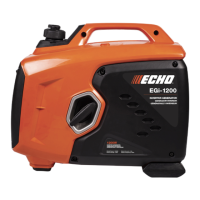
Do you have a question about the Echo EGi-1200 and is the answer not in the manual?
| Starting Watts | 1200W |
|---|---|
| Running Watts | 1000W |
| AC Voltage | 120V |
| Rated Amperage | 8.3A |
| DC Voltage | 12V |
| DC Output | 8A |
| Power Output | 1000W |
| Output Voltage | 120V |
| Frequency | 60Hz |
| Waveform | Sine Wave |
| Protection Features | Overload Protection |
| Cooling | Air-cooled |
Explains the importance and purpose of the operator's manual for safe and effective generator use.
Provides space to record model and serial numbers for servicing and warranty claims.
Defines safety alert symbols, signal words (DANGER, WARNING, CAUTION, NOTICE), and hazard symbols with their meanings.
Warns about the deadly, odorless gas produced by generator exhaust and provides strict outdoor usage guidelines.
Details critical safety precautions for handling flammable and explosive fuel, including filling and storage.
Emphasizes the risk of electrocution from improper grounding and safe electrical connection practices.
Identifies and labels the external parts of the generator, such as carrying handle and fuel tank cap.
Details the function and location of each indicator and control on the generator's panel.
Explains the operation of the 3-in-1 switch knob for starting, stopping, and choke control of the engine.
Describes the function of the oil warning light and the overload indicator light on the control panel.
Explains that the AC pilot light indicates when the engine has started and is producing power.
Details the DC protector function for overcurrent protection and the Engine Smart Control (ESC) feature.
Describes how to operate the fuel tank cap and air vent knob, and the function of the ground terminal.
Provides instructions and safety precautions for filling the fuel tank and engine with oil.
Outlines essential checks to perform before starting the generator, including fluid levels and general condition.
Provides detailed instructions and safety warnings for properly grounding the generator and connected appliances.
Provides step-by-step instructions for safely starting and stopping the generator engine.
Explains how to safely connect electrical devices to the generator's AC outlets.
Outlines the procedure for charging a 12V battery using the generator's DC output.
Specifies the generator's power output capabilities for AC and DC loads and advises on total load management.
Presents a schedule for regular maintenance tasks, including frequency and specific items to check or replace.
Details the procedure for inspecting the spark plug, including cleaning, checking for discoloration, and gap adjustment.
Provides instructions and safety precautions for draining and refilling the engine oil.
Explains how to remove, clean, and oil the air filter element for optimal engine performance.
Describes how to remove, clean, and reinstall the fuel filter to ensure clean fuel delivery to the engine.
Provides instructions on how to safely drain the fuel system for long-term storage to prevent fuel degradation.
Outlines steps to protect the engine from corrosion and damage during storage, including cylinder lubrication.
Lists common causes and solutions for the engine failing to start, covering fuel, oil, and electrical systems.
Addresses problems where the generator does not produce power, focusing on safety devices and pilot lights.
Lists key technical data for the generator, including model, voltage, power output, and noise level.
Explains how to connect two generators together for increased power output using parallel cables.
Outlines the terms, conditions, coverage periods, and exclusions of the manufacturer's limited warranty.
Explains the warranty coverage for exhaust and evaporative emissions control systems, including owner responsibilities.